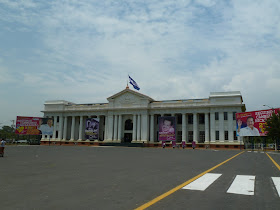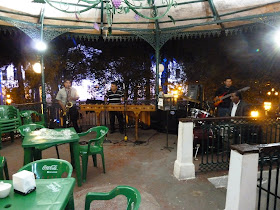23rd - 26th May 2011
 |
| Viva El Presidente 'Comandante Daniel' Ortega |
TICA bus again out of San Salvador, through a bit of Honduras and into Nicaragua at Somotilla then past Leon to Managua. 14 hours. The countryside on this journey became progressively flatter and poorer although still quite lush and green with big hills, mountains and volcanos in the distance. Interestingly, Honduras alone in Central America has no volcanos - some freak of tectonic plate distribution.
The border stops were a bit of a pain in the arse due to it being stifling hot, getting bags on and off the bus and a long wait for them to be searched, or not, at the whim of customs officials. There was a distinct lack of porters.
The bus was full and there were some curious occupants ( excluding me of course ). Two, what looked like Amish women, stood out as did a very bossy 'schoolmistress' of a tour leader who never stopped telling her charges, loudly, what they should be doing, or not. She was very irritating, and some of her 'tour party' seemed a bit weird too, particularly a German chap who looked just like Benny Hill in long khaki shorts and a big hat and wandered around the bus being 'Serr Amusink', or so he thought. We could all, including the Amish ladies, have happily shot him.
Managua is a real dump. It is mostly, in the centre, a semi-cleared bomb site or, more accurately, earthquake site. The major earthquake which flattened the place occurred in 1972. Due to the utterly corrupt Samosa dictatorship which spent all the aid money on their armed forces and not rebuilding, followed by the Sandinista guerrillas ( FSLN ) taking power in 1979 which led to further civil war, nothing got done. The Sandinistas were led by El 'Comandante Daniel' Ortega. The US backed another loser here in the shape of the 'Contras' in support of the ousted Samosa regime ( just because they weren't 'commie bastards' I suppose ). Anyway, Ortega was replaced in 1990 and some progress was made. Ortega is now back in power again as President. Viva El Comandante Daniel! What a survivor.
The border stops were a bit of a pain in the arse due to it being stifling hot, getting bags on and off the bus and a long wait for them to be searched, or not, at the whim of customs officials. There was a distinct lack of porters.
The bus was full and there were some curious occupants ( excluding me of course ). Two, what looked like Amish women, stood out as did a very bossy 'schoolmistress' of a tour leader who never stopped telling her charges, loudly, what they should be doing, or not. She was very irritating, and some of her 'tour party' seemed a bit weird too, particularly a German chap who looked just like Benny Hill in long khaki shorts and a big hat and wandered around the bus being 'Serr Amusink', or so he thought. We could all, including the Amish ladies, have happily shot him.
Managua is a real dump. It is mostly, in the centre, a semi-cleared bomb site or, more accurately, earthquake site. The major earthquake which flattened the place occurred in 1972. Due to the utterly corrupt Samosa dictatorship which spent all the aid money on their armed forces and not rebuilding, followed by the Sandinista guerrillas ( FSLN ) taking power in 1979 which led to further civil war, nothing got done. The Sandinistas were led by El 'Comandante Daniel' Ortega. The US backed another loser here in the shape of the 'Contras' in support of the ousted Samosa regime ( just because they weren't 'commie bastards' I suppose ). Anyway, Ortega was replaced in 1990 and some progress was made. Ortega is now back in power again as President. Viva El Comandante Daniel! What a survivor.
 It makes San Salvador appear positively pristine in comparison. Some trees, and weeds, have fortuitously grown up to conceal the worst of the place. The locals enjoy demonstrating , and some obliged as we went on a look-see ( left ).
It makes San Salvador appear positively pristine in comparison. Some trees, and weeds, have fortuitously grown up to conceal the worst of the place. The locals enjoy demonstrating , and some obliged as we went on a look-see ( left ). The city centre area where I was ( unwittingly ) staying in a dilapidated hotel called Los Felipe ( $20 per night ) was a shanty town. There were cleared areas, derelict buildings and some old 'plazas' with a few abandoned looking Grand Edifices which are used occasionally for state sponsored rallies and parades.
Right: The Plaza de La Republic ( Somosa era ), which became The Plaza de La Revolution ( Sandinistas era ), then Plaza de La Republica ( post Sandinista ), now Plaza de La Revolution again ( Ortega is back ), is the venue for parades and of the deserted Presidential Palace.

Left: On another side is the unused ( I think ) Cathedral. Lots of weeds on the fenced off steps.
On the plus side, maybe, there were not so many armed guards around, presumably because there was bugger-all worth guarding, apart from the petrol stations.
Would you believe it, yes you would by now, there was an Oirish bear a couple of blocks away! I taxied over ( all of 300yds ). The redoubtable Michael was holding the fort. He had Guiness, in tins, and one other, American, customer. Originally an electrician from Cork, Michael came to Honduras 27 years ago to help in refugee camps over the border from Nicaragua. He stayed and is a fount of knowledge about the place and lots of other things as well. I think he is married to a local ( a 'nicca' as they are fondly referred to by ex-pats and locals alike ) and has two children.
The city is definitely a 'no walk zone' especially after dark. Lads high on 'crack-cocaine' stalk the streets ( apparently ) waiting to pounce on locals and tourists alike. I used a taxi, supplied by the hovel, sorry hotel, to get around. The driver, Bayardo, was a splendidly cheerful chap. He had been a Sandinista guerrilla. He proudly showed me a photo of him being presented with an award of some sort by Comandante Ortega himself in the 1980s.
The upside of this place is, I suppose, that it is cheap. Or at least where I went it was.
Left: The 'silhouette' of Augusto Sandino, after whom the Sandinistas were named. He was a leftist revolutionary in the 1930s and was executed on this spot by the then ruling Somosas ( they held power for a long time ). It is on a hill and can be seen against the sky from just about everywhere in the city. Senor Sandino was famous for his hat. Here he looks a bit like one of those rifle-range targets which 'falls when hit'.
Right: A view over the 'city' from this hill looking north towards lake Managua. Not a very inspiring sight. It looked much the same in all the other directions. I never did find out where the 'posh' area was. Carefully hidden, no doubt.
Bayardo, the reformed guerrilla, drove me the 30 miles north-east to Granada. We had to stop for a beer on the way. It was so HOT!
Anyway, Granada is another world altogether. It is on the shore of Lake Nicaragua ( a vast lake ) and is truly a revelation after Managua. The town is 'Ye Olde Worlde' colonial Spanish and utterly charming. Somewhat similar to San Christobal ( Mexico ) and Antigua ( Guatemala ). Some wrecked old churchs but otherwise neat and tidy and very 'touristy' in fact. There are smart hotels and restaurants and Spanish language schools. It is one of few showpieces in Nicaragua.
Left: The Alhambra Hotel. Comfortable and excellent service and $50 per night. Not too bad. There were several much more expensive and presumably some cheaper. It was on the central Plaza......
Right: ....which was of typical variety; ie Cathedral, bandstand ( seen here ), statues, flagpole etc. Plus a vast array of carriages. There was a considerable whiff of horse manure which drifted into the hotel. Very comforting.
The locals used a lot of wonky looking horsedrawn carts to transport their goods. The carts and horses, of a spindly variety, both looked equally decrepit and vied for road room with taxis, motorbikes and the ever present 'chicken' buses. Quite a rustic scene.
Left: Just in case you thought this might be the odd place out, you were, of course, wrong. Here it is. The Oirish bear. O'Shea's, owned and run by a most amusing Irishman from County Dublin called Tom. He was quite an authority on the Irish racing scene and had once part owned a racehorse. That's probably why he is in Nicaragua.
Right. Tom on parade at O'Shea's. This really was a true Irish venue. They did an excellent Irish stew. There was also a Pub Quiz night on my last evening there, run by a young Irish couple. It was great fun and attracted a big crowd. I teamed up with a Canadian girl form Toronto, a teacher, called Megan and a 'Nicca' colleague of hers, Aaron. They were quite knowledgeable and after 4 rounds of good questions ( apart from the pop and movie section ) ie Q...'how many stomachs does a cow have?'...A... 'four'. Eny fule kno that ( apart from me ), we had done reasonably well and finished mid-field.
Right: A religious procession of some sort. The musicians were very loud and jolly if not entirely in tune or playing any recognisable melody.

Left: I look in at the swimming pool of one of the grander hotels, The Granada. A lovely place with all mod cons. This whole town was in no way similar to dirty old Managua.
Lake Nicaragua, nearby, offered all sorts of sport and recreation. Fishing, sailing, canoeing, bicycling and, for the twitchers, bird watching.















































